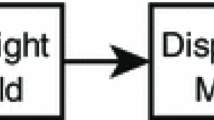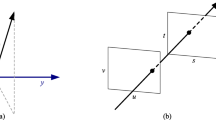Abstract
The light field is a 4D function that represents the radiance of light traveling in every direction through every point in 3D space. In this paper, we demonstrate how effectively 4D light fields can be sampled from the real world using a custom-built 4D light field camera system constructed based on cheaply and commonly available Raspberry Pi computers. The camera system consisting of a camera array and a dedicated calibration software is flexible and scalable in structure because the system can be reconfigured easily to meet the user’s needs. We show the effectiveness of the camera system by interactively visualizing captured 4D light fields using our GPU-accelerated light field renderer supporting a virtual camera model that synthesizes various photographic effects including zooming and panning, refocusing, focus breathing, and depth-of-field control. We believe that the do-it-yourself 4D light field camera will be explored effectively in traditional application fields, such as computer graphics and vision, and in other areas like science education.












Similar content being viewed by others
References
Aaftab Munshi, L.H., Sochacki, B.: The OpenCL C Specification (Version: 2.0), 30th edn. Khronos OpenCL Working Group (2015)
Adelson, E.H., Bergen, J.R.: The plenoptic function and the elements of early vision. In: Landy, M., Movshon, J.A. (eds.) Computational Models of Visual Processing, Chapter 1. The MIT Press, Cambridge (1991)
Adelson, E.H., Wang, J.Y.: Single lens stereo with a plenoptic camera. IEEE Trans. Pattern Anal. Mach. Intell. 14(2), 99–106 (1992)
Adhikarla, V.K., Marton, F., Balogh, T., Gobbetti, E.: Real-time adaptive content retargeting for live multi-view capture and light field display. Vis. Comput. 31(6–8), 1023–1032 (2015)
Brown, D.C.: Close-range camera calibration. Photogramm. Eng. 37(8), 855–866 (1971)
Burden, R.L., Faires, J.D.: Numerical Analysis. Cengage Learning, Boston (2010)
Donatsch, D., Bigdeli, S.A., Robert, P., Zwicker, M.: Hand-held 3D light field photography and applications. Vis. Comput. 30(6–8), 897–907 (2014)
Foundation, R.P.: Raspberry Pi. https://www.raspberrypi.org/. Accessed 22 Jan 2016
Georgeiv, T., Zheng, K.C., Curless, B., Salesin, D., Nayar, S., Intwala, C.: Spatio-angular resolution tradeoffs in integral photography. In: Eurographics Symposium on Rendering, pp. 263–272 (2006)
Gortler, S.J., Grzeszczuk, R., Szeliski, R., Cohen, M.F.: The lumigraph. In: Proceedings of the 23rd Annual Conference on Computer Graphics and Interactive Techniques, SIGGRAPH ’96, pp. 43–54 (1996)
Hartley, R., Zisserman, A.: Multiple View Geometry in Computer Vision. Cambridge University Press, Cambridge (2004)
Levoy, M., Hanrahan, P.: Light field rendering. In: Proceedings of the 23rd Annual Conference on Computer Graphics and Interactive Techniques, SIGGRAPH ’96, pp. 31–42 (1996)
Levoy, M., Ng, R., Adams, A., Footer, M., Horovitz, M.: Light field microscopy. ACM Trans. Graph. 25(3), 924–934 (2006)
Liang, C.K., Lin, T.H., Wong, B.Y., Liu, C., Chen, H.H.: Programmable aperture photography: multiplexed light field acquisition. ACM Trans. Graph. 27(3), 55 (2008)
Lin, X., Wu, J., Zheng, G., Dai, Q.: Camera array based light field microscopy. Biomed. Opt. Express 6(9), 3179–3180 (2015)
Lytro: Lytro. https://www.lytro.com/. Accessed 22 Jan 2016
Ng, R.: Digital Light Field Photography. Ph.D. thesis, Stanford University (2006)
Ng, R., Levoy, M., Brédif, M., Duval, G., Horowitz, M., Hanrahan, P.: Light field photography with a hand-held plenoptic camera. Comput. Sci. Tech. Rep. CSTR 2, 1–11 (2005)
OpenCV: OpenCV. http://opencv.org/. Accessed 22 Jan 2016
Raytrix: Raytrix. https://raytrix.de/produkte/. Accessed 22 Jan 2016
Shirley, P., Chiu, K.: A low distortion map between disk and square. J. Graph. Tools 2(3), 45–52 (1997). https://doi.org/10.1080/10867651.1997.10487479
Stroebel, L., Compton, J., Current, I., Zakia, R.: Photographic Materials and Processes. Focal Press, Boston (1986)
Veeraraghavan, A., Raskar, R., Agrawal, A., Mohan, A., Tumblin, J.: Dappled photography: mask enhanced cameras for heterodyned light fields and coded aperture refocusing. ACM Trans. Graph. 26(3), 69 (2007)
Venkataraman, K., Lelescu, D., Duparré, J., McMahon, A., Molina, G., Chatterjee, P., Mullis, R.: PiCam: an ultra-thin high performance monolithic camera array. ACM Trans. Graph. 32(6), 166 (2013)
Wanner, S., Goldluecke, B.: Globally consistent depth labeling of 4D light fields. In: 2012 IEEE Conference on Computer Vision and Pattern Recognition (CVPR), pp. 41–48 (2012). https://doi.org/10.1109/CVPR.2012.6247656
Wilburn, B., Joshi, N., Vaish, V., Talvala, E.V., Antunez, E., Barth, A., Adams, A., Horowitz, M., Levoy, M.: High performance imaging using large camera arrays. ACM Trans. Graph. 24(3), 765–776 (2005)
Yang, J., Everett, M., Buehler, C., McMillan, L.: A real-time distributed light field camera. In: Eurographics Workshop on Rendering, pp. 1–10 (2002)
Zhang, C., Chen, T.: A self-reconfigurable camera array. In: Eurographics Workshop on Rendering, pp. 243–254 (2004)
Acknowledgements
This research was supported by Basic Science Research Program through the National Research Foundation of Korea (NRF) funded by the Ministry of Education (No. NRF-2017R1D1A1B03029625).
Author information
Authors and Affiliations
Corresponding author
Electronic supplementary material
Below is the link to the electronic supplementary material.
Appendix: Estimation of the rigid body transformation for finding the geometry parameters of the camera array
Appendix: Estimation of the rigid body transformation for finding the geometry parameters of the camera array
Let \(M(\alpha , \beta ;\theta ) = T(\alpha , \beta )R(\theta )\) be the rigid body transformation we are to seek. The transformed position \(\bar{\mathbf{P}}_{ij}\) of \(\mathbf{P}_{ij}\), the center of the (i, j)-th grid cell, is then
where
The squared sum of the distances between \(\bar{\mathbf{P}}_{ij}\) and \(\mathbf{P}^*_{ij}= (x^*_{ij}, y^*_{ij})^t\), the projected position of the (i, j)-th camera in the 2D coordinate system, is now expressed as
Then,
From \(F(\alpha , \beta ;\theta ) = 0\) and the similarity between the two variables \(\alpha \) and \(\beta \), we find the total error is minimized at \((\alpha ^*, \beta ^*)\) where
Next, for the remaining variable,
To estimate \(\theta ^*\) such that \(\frac{\partial F}{\partial \theta } = 0\), the Newton–Raphson method [6] is applied to the function \(f(\theta ) = S \sin \theta - C\cos \theta \) with \(S = \sum _{j=0}^{9} \sum _{i=0}^{9} (x_{ij}^{*}+y_{ji}^{*}) x_{ij}\) and \(C = \sum _{j=0}^{9} \sum _{i=0}^{9} (x_{ji}^{*}+y_{ij}^{*}) y_{ij}\). Note that since the rotational displacement is usually small, the following Newton–Rapson iteration converges quickly to the solution \(\theta ^*\) for the initial value \(\theta _0 = 0\):
Rights and permissions
About this article
Cite this article
An, J., Park, S. & Ihm, I. Construction of a flexible and scalable 4D light field camera array using Raspberry Pi clusters. Vis Comput 35, 1475–1488 (2019). https://doi.org/10.1007/s00371-018-1512-z
Published:
Issue Date:
DOI: https://doi.org/10.1007/s00371-018-1512-z




